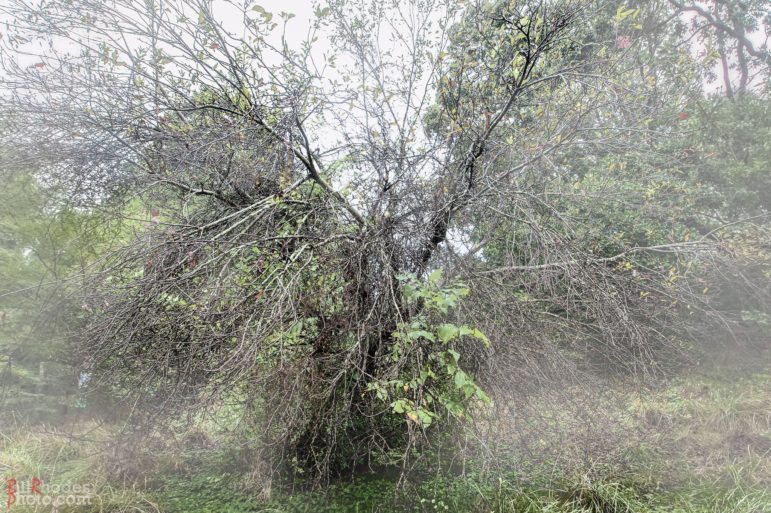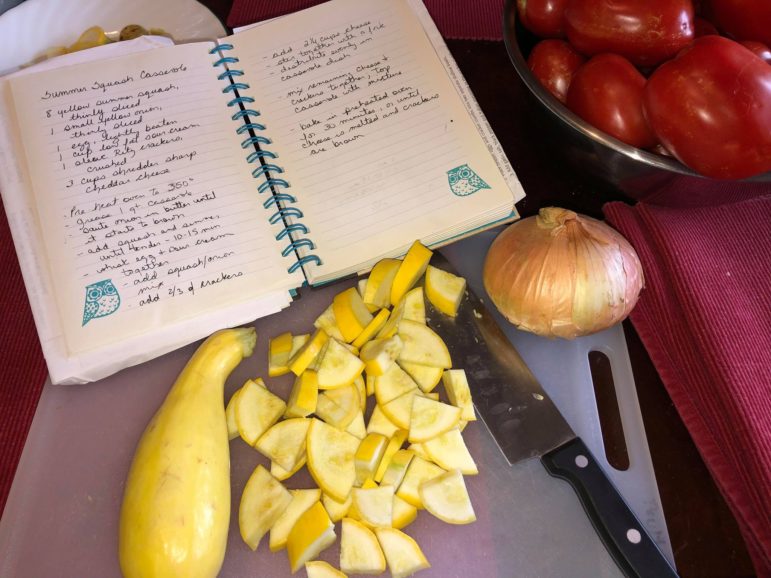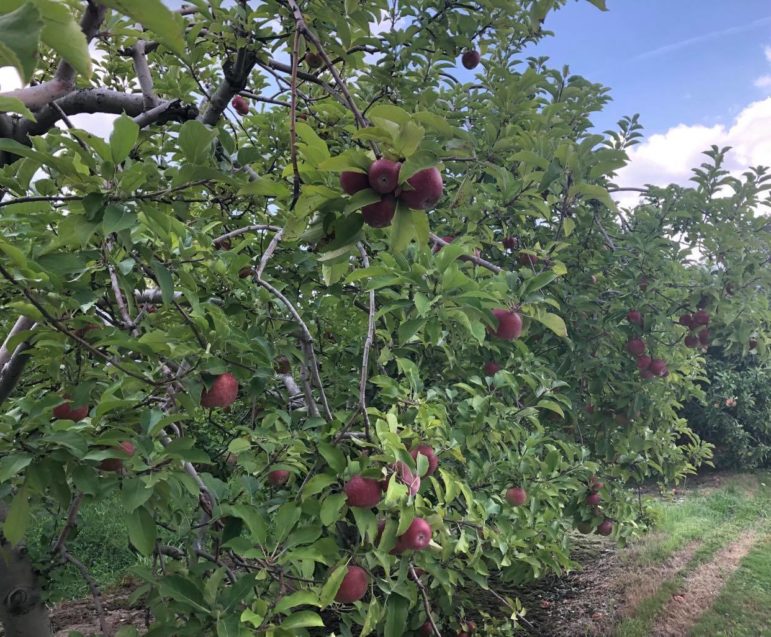
The apple tree at the top of the meadow was probably here when this part of the Swannanoa River Valley was active farmland. Across from that tree, under intertwined branches of juniper and locust, is a small bench where I like to sit. It is a peaceful place. The view is restful and offers a chance to observe black bears, birds, and other wildlife.
While I am in that space, I usually remain in the moment and enjoy being present in nature. Sometimes I slide into meditation or vision or daydreams. Every once in a while, the scene in front of me changes in the blink of an eye, as happened on a recent afternoon. I was hoping to catch sight of some bears my husband had seen move from a neighboring tree into the meadow but saw something even more marvelous.
In my vision, that single remaining apple tree marked the southern boundary of a small orchard, not 50 yards from the farmhouse that once stood on this land. The orchard filled the meadow with trees that were laden with fruit that was beginning to ripen. Although there were not enough trees to make a marketable crop, what there was would provide for a family or two.
From a practical point of view, it makes sense that farmers here would grow apples. This area of western North Carolina is apple country. From a spiritual relationship with the land point of view, it seems right. My gardens are proof that this land loves to grow things.
As I watched the play of light and the flight of pollinators in the orchard, I was overcome by a sense of harmony so deep and abiding that I will carry it with me forever. Bemused, I asked the land spirits whether this was a daydream, or had I slipped into liminal space?
With what can only be described as an “we can neither confirm nor deny” stance, they shifted my attention back to the land that I occupy in this here and now. In another blink of an eye, I was once again staring at a single tree standing at the top of a meadow.

The old apple tree [B. Rhodes]
The tree is old. Many of the lower branches produce neither leaves nor flowers, and the bark is rough and spotty with light green moss. Their existence has been repurposed; that which was once air giver and fruit maker has become a set of skeletal gray monkey bars for bear cubs. Indeed, some of the branches are so dry and brittle that the sound of them breaking is sometimes the first indicator of the presence of bears.
Early in the spring of this year, the tree appeared to be dead. As the season progressed, I was surprised to see new growth come in at the top of the tree. Those upper branches appear to be strong and have a healthy show of green leaves. They are filled with apples, already turning red and growing ripe.
Held in deep contemplation of this not-quite still life, I allowed my mind’s eye and spirit to sift through the color, light, and changing shadow to find the meaning contained therein.
The afternoon air was cool and sweet, more like the approaching autumn than the summer about to be left behind. There was a difference in the shade of blue that colors the sky, and the quality of light was already changing as the wheel turns towards the golden hours of the year.
Seeing the different levels of the apple tree in that context pulled my thoughts towards the significance of the harvest season. That tree, as it stands now, is presenting itself in every stage of its life cycle; new seeds inside ripe fruit and the fruit itself, new growth, green leaves, old and dying branches, dead leaves, and branches that have fallen to the ground where over time they will contribute to the life of the tree.
My gardens are in the same state. I cannot count the number of times during this past spring and summer that I have marveled at the way leaves, blossoms, color, scent, ripe fruit, and seed pods roll through across the landscape like waves cresting over days and weeks and seasons.
Milkweed has gone from purple blooms to fluffy opened seed pods. The fragrant white blossoms that crowned the elderberry are now a mix of berries in varying stages of ripeness. The echinaceas are nearly barefaced seed heads; most of the petals that framed them dropped to the ground. Even the bee balm is done for the season. But the black-eyed Susans are in their glory, the autumn joy sedum is just starting to get color, and the calendula and chamomile will keep blooming until well into September.
I have enjoyed a good harvest of medicinal herbs, flowers, and elderberries. The tomatoes and okra are still producing at a good rate, providing enough for this three-person household and some of the wildlife that visits my land. How the goldfinches love to feast on the sunflower heads!
Still there stands that old apple tree, reminding me that not everything has produced as it could have or should have or once did.
Mockingbirds stripped the berries from the Juneberry trees before they were even ripe. Tomatoes are flourishing in the vegetable garden, but the squash and zucchini haven’t produced a single fruit. Late in the spring, I increased the size of my chicken flock, but out of 10 hens only two are currently laying eggs. One of the old girls has aged past laying, and another recently died.

Cutting up a squash for a casserole (with a bonus recipe!) [S. Barker]
Processing these thoughts, especially thinking about squash, made me decide that I need to make a trip to my favorite farm stand to buy some yellow squash to make a favorite summer casserole. And at the moment that thought rolled through my mind, the land spirits made a collective “ahem” sound to get my attention. (Ah, the farm stand.)
Last year I made great efforts to preserve food. I canned and froze chicken, tomatoes, squash, zucchini, potatoes, carrots, green beans, applesauce, apple butter, strawberries, blueberries, blackberries, and peaches. I made strawberry and blackberry jam and apple jelly. And here it is, the end of August, and I haven’t canned a single thing. My attention has been focused on writing and healing, and although that included tending and harvesting the healing garden, I have neglected the important work of food preparation.
The land spirits are drawing my attention to the fact that while my lazy summer is drawing to a close, the harvest season isn’t anywhere near over. I still have time to do the work that will fill the pantry and help feed my family through the winter.
Events and supply shortages that began during the pandemic made it clear that it is important to be as self-sustaining as possible. While it is unlikely that I will ever have a garden that will feed my small family year-round, purchasing produce from farm stands and is the next best option towards that goal. To that end, I have made plans to make some farm stand trips and start canning what is still in season.
The land spirits probably never had to work so hard to keep a farm family focused on providing for their people. I am grateful that my relationship with them has grown so much that they think I am worth some effort.

A green and growing apple orchard [S. Barker]
In the days since I wrote the first draft of this column, some fierce and terrible storms moved through this region. In 36 hours more than 12 inches of rain fell in my gardens. In the after-storm peace of this morning, I walked my property and went to look at the apple tree. I was sad to see that it suffered some damage.
I wandered through contemplation again, thinking about that tree and how much work the families who lived here had to put into surviving. About how they started something here years ago, and even though they are no longer here, the land still thrives. About the plants in my gardens and watching them move through sprout to bloom to seed-bearing to dying. Sometimes they die early. Sometimes they don’t bloom or don’t produce the crop I had hoped for or expected. Sometimes the bears, raccoons, or other creatures take the harvest.
Those losses do not change how I feel about my connection to my land or the grand, delightful, wonderful experiment of trying new things, learning from unexpected results, and then trying again. Because of that marvelous reciprocal relationship, we are building a tiny community for pollinators and wildlife and humans to share.
Out of loss can come growth, and out of growth new beginnings are made possible. As that realization came to me, I spoke those words out loud, and I am certain I heard a collective sigh from the land spirits. They are relieved that I finally got the message.
I will grieve a little as the blooming season passes, which is quite normal. But no doubt in that grief I will remember the apple tree and how she surprised me. How she fed the bears and other critters even though it seemed she was past her time. Perhaps she will surprise me again.
Thinking of her as she looked a few days ago compared to how she looks today, stark and broken against the gray sky, brought a great deal of clarity and understanding.
Within the cycle of life and death, beginnings and endings, happiness and grief, there is always an underlying thread that keeps it all connected, that ties beginning to end to new beginning. Maybe it is hope, maybe it is faith, maybe it is magic; call it what you will, but it is there.
When I started the gardens here in part as a path towards healing for myself, I made an agreement with my lands and the land spirits. I truly had no idea how mutually enriching that would be.
I work to nurture and sustain the plants, the soil, and the land spirits, and they do the same for me.
The Wild Hunt always welcomes guest submissions. Please send pitches to eric@wildhunt.org.
The views and opinions expressed by our diverse panel of columnists and guest writers represent the many diverging perspectives held within the global Pagan, Heathen and polytheist communities, but do not necessarily reflect the views of The Wild Hunt Inc. or its management.
The Wild Hunt is not responsible for links to external content.
To join a conversation on this post:
Visit our The Wild Hunt subreddit! Point your favorite browser to https://www.reddit.com/r/The_Wild_Hunt_News/, then click “JOIN”. Make sure to click the bell, too, to be notified of new articles posted to our subreddit.
